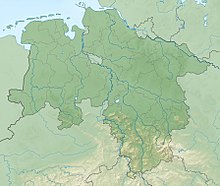Emsauen between the mouth of the Leda and Oldersum
Coordinates: 53 ° 13 ′ 40 ″ N , 7 ° 25 ′ 10 ″ E
The Emsauen between the mouth of the Ledam and Oldersum are a former nature reserve in the city of Leer and in the communities of Westoverledingen , Jemgum and Moormerland in the district of Leer .
description
The nature reserve with the registration number NSG WE 272 was around 600 hectares in size. It was completely part of the 4,019 hectare EU bird sanctuary “Emsmarsch from Leer to Emden” and, with the exception of a 3.5 hectare sub-area at the mouth of the Leda, also part of the 7376.81 hectare FFH area “Unterems and Außenems”. The area has been under protection since February 3, 2009. On June 15, 2017, it was added to the newly designated " Unterems " nature reserve . The responsible lower nature conservation authority was the district of Leer.
The former nature reserve, which consisted of six partial areas, extended on both sides of the Ems between the mouth of the Leda south of Leer and Oldersum , a district of the municipality of Moormerland south-east of Emden . It placed parts of the dike foreland as well as the river island Bingumer Sand lying in front of Bingum and the river island Hatzumer Sand lying near Oldersum under protection. In the area of the two river islands, parts of the Ems are included in the nature reserve.
The former nature reserve is primarily characterized by reed brackish water and grassland areas of varying moisture and intensity of use. In places there are salt marshes . The forelands are crossed by tides in places . Together with the Rheiderland , the Dollart and the marshes to the right of the Ems, the area is an important wintering and resting area for Nordic geese.
The Bingumer Sand is padded in its central area . The grassland is grazed extensively. The Hatzumer Sand is not subject to any use. It is almost completely consumed by reeds . There are several deep creeks on its east side. The fore dike area southeast of the Hatzumer Sand is partially polded. It is only flooded when the Ems water levels are particularly high. To the north of the Nüttermoorer Sieltiefs there is a former rinsing area . Here are willows settled.
Compensation measures were carried out in parts of the former nature reserve . Areas previously used are now left to their natural succession . Compensation measures were also carried out on the Bingumer Sand. Here, an elevated water level is maintained in the polder by means of inflow structures. Water areas created as part of the compensation measures are subject to natural succession.
At Midlum , the former nature reserve is interrupted by the area of the former brickworks in the outer dike area and the Midlum Sielmuhde. At Oldersum, the access to the port runs through the former nature reserve.
Flora and fauna
The area is an important habitat for a species-rich avifauna . It is of particular importance for reed breeders, various Limikolen as well as ducks , geese and swans . The area is also an important resting and wintering area, especially for Limikolen and geese. Harrier , corn and marsh harrier are native to the former nature reserve . The short-eared owl also occurs here. Limikolen are u. a. by Ruff , Bekassine , Curlew , Uferschnepfe , Säbelschnäbler , red and green leg , peewit , Sandpiper , Redshank and Green Sandpiper and Plover Goldregenpfeifer , Seeregenpfeifer and Plover , Anatidae by the ducks Brandgans , spit , spoon , Krick- , Knäk - , Gadwall , Tableware and Goldeneye , the goose -footed , seeds , wood pigeon and Canada geese , and swans cusp , minke and Singschwan represented. Furthermore, in the area grebes , geese and Smew and various gulls , including storm , silver , herring , coat and Gull . Songbirds are u. a. represented by skylark , reed warbler , reed swirl , bearded tit , bluebin and whinchat . The area is also a habitat for bitterns , herons , quail and the Coot Spotted Crake and coot . Guest birds in the former nature reserve are u. a. Gray goose , white-fronted goose , barnacle goose , widgeon and Whimbrel .
Web links
- Ordinance on the nature reserve "Emsauen between the mouth of the Ledam and Oldersum" , Leer district, January 28, 2009 (PDF file, 55.3 kB)
Individual evidence
- ^ Emsmarsch from Leer to Emden , profiles of the Natura 2000 areas, Federal Agency for Nature Conservation . Retrieved April 12, 2018.
- ↑ Unterems and Außenems , profiles of the Natura 2000 areas, Federal Agency for Nature Conservation. Retrieved April 12, 2018.

